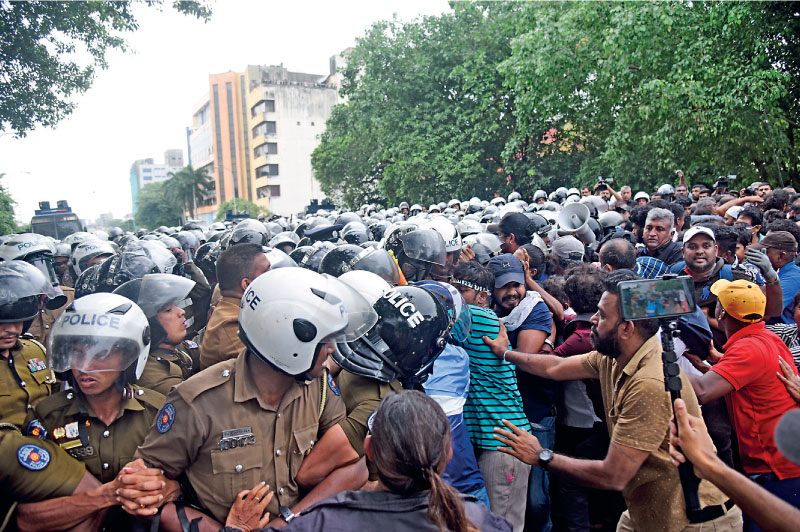Sunday Apr 27, 2025
Sunday Apr 27, 2025
Thursday, 1 December 2022 00:00 - - {{hitsCtrl.values.hits}}

The State’s response to people’s outcry was unsurprising, given Sri Lanka’s history of a powerful executive, a constitution that failed to strengthen democracy and decades of investment in laws and policies of repression, including militarisation
 In 2022, a youth-led citizens’ movement succeeded in ousting Sri Lanka’s all-powerful President, Prime Minister, and the Cabinet whom they held responsible for the island nation’s painful economic crash. The movement was the result of the people’s outcry for basic needs, seeking relief from economic distress and demanding justice and accountability for the crisis. The events that followed, however, saw the old political guard manoeuvre structures of power to cling on it.
In 2022, a youth-led citizens’ movement succeeded in ousting Sri Lanka’s all-powerful President, Prime Minister, and the Cabinet whom they held responsible for the island nation’s painful economic crash. The movement was the result of the people’s outcry for basic needs, seeking relief from economic distress and demanding justice and accountability for the crisis. The events that followed, however, saw the old political guard manoeuvre structures of power to cling on it.
An authoritarian constitution and legal framework
The State’s response to people’s outcry was unsurprising, given Sri Lanka’s history of a powerful executive, a constitution that failed to strengthen democracy and decades of investment in laws and policies of repression, including militarisation. Unchecked executive powers saw the President, including the newly appointed Ranil Wickremesinghe, lavishly use anti-terror laws, declarations of emergency, curfews, deployment of the military and attempts to demarcate popular protest sites as high security zones.
The police resorted to tactics of provoking protestors, making sweeping arrests and intimidating crowds at protest sites by firing tear gas, water cannons and installing barricades fixed with menacing spikes. Protestors were repeatedly summoned to give statements at police stations under the threat of arrest. Their homes were raided and families threatened. Undeniably, the state responded disproportionately with violence, force and intimidation to stifle people’s discontent, anger and pleas for help.
Sri Lanka’s constitution by design lends itself readily to authoritarian rule. An all-powerful executive presidency has meant that many policy decisions rarely respond to or have been informed by people’s needs. Judicial institutions are distant from the people. For example, the judiciary has no power to declare an existing law unconstitutional and citizens are shut out of courts by impractical time-bars of one month to complain of violations of their rights. Legislative processes also fail to involve the public, are not transparent. People often find themselves ambushed by law reform.
The continuing battleground over enacting laws for the independence of institutions have resulted in the 17th, 18th, 19th, 20th and the recent 21st amendments to the constitution which seek to merely make minor changes, instead of genuine structural change. Who does the recent 21st amendment to the constitution serve? President Ranil Wickremesinghe or the people? If it was in the interest of the people, we would have seen the abolishment of the executive presidency – something that remains an unfulfilled promise of many presidents before him.
Weak legal protections for Sri Lankans
More laws have been developed to repress and control rather than protect the interest of the people of Sri Lanka. The country has failed to enact laws to address discrimination and violence against women and recognise women’s labour and their contribution to the economy. There has been inadequate legal reform to protect children and address disputes within families.
Working people’s rights to fair wages, decent working conditions, right to organise, and secure social protections are often breached by employers without consequences. No legal reforms have responded to these realities. Laws to address land disputes, housing issues, access to basic resources for living, and securing a sustainable environment are underdeveloped. Furthermore, investing in education, health and equitable development has been on the back burner since the late 1970s.
Laws have also failed to address discrimination of minorities and deliver justice and accountability for past violations. Furthermore, ethnicised electoral politics and no meaningful mechanisms for the devolution of power to the island’s provinces and local government bodies have constrained the space for democratic participation.
The lack of recognition of socioeconomic rights in the constitution leaves the people without a legal framework to find recourse for the numerous violations they encounter on a daily basis. The economic crisis exposed the interests the system is designed to serve - interests of capital and the political elite. People’s protests are a challenge to the existing economic order, authoritarian rule and in effect the deficiencies of the constitution.
Unequal impact of the crisis
The Sri Lankan Government has ensured that the most pressing needs of the middle-class, fuel and electricity, are met. Masked by the middle-class sentiment of, “things are much better now,” is the devastation of the crisis on the lives of daily-wage earners, the urban poor, women, children and marginalised communities.
Headline inflation peaked at 69.8% in September, while food inflation reached a staggering 94.9%, making essential goods unaffordable for the majority of the population. Kerosene prices have quadrupled, forcing fisherfolk to reduce their trips out to sea and a chance at earning an income. This is significant given that fish is the main source of protein on the island. Farmers are abandoning cultivation due to soaring costs of fertilisers, even as the food system was made precarious with the Executive’s drastic ban on chemical fertiliser in 2021.
Experts have warned that almost one third of the population is facing food insecurity and 86% of households have either reduced the quantity of their food intake or nutritional food items. Almost 17% of children under 5 years are facing malnutrition, with signs of wasting and stunting. The long-term effects of the economic crisis are already visible. Even the unlikely scenario of a quick exit out of the debt crisis and access to external financing will not eliminate these effects.
Economic policies fail the people
The economic crisis has been long in the making. Sri Lanka’s foreign loans, half of which are sovereign bond market debt, were invested mainly in large-scale infrastructure projects, Such investments failed to realise economic benefits for ordinary Sri Lankans. The country has been experiencing a balance of payments deficit for years. Its foreign exchange reserves dwindled to less than $ 2 billion in July 2022, making essential imports unaffordable.
In response to the crisis, the government implemented dramatic measures such as doubling the interest rates and announcing a hurried default on all its foreign debt obligations. Having sought assistance from the IMF, a staff level agreement was reached to obtain $ 2.9 billion over a 48-month period subject to restructuring of Sri Lanka’s foreign debt. The conditionalities of the IMF as outlined in the staff-level report include addressing budget deficits via severe austerity measures. These measures contribute to the hardships faced by the people. Its recommendations for law reforms, including flexible labour laws and increasing female labour force participation, can pave the way for greater exploitation of cheap labour.
Sri Lanka has one of the most regressive tax systems worldwide. Instead of increasing direct taxes, the former Gotabaya Rajapaksa regime gave away generous tax breaks to corporations and the rich, which left the state coffers empty. Value Added Taxes were the first to be increased amidst the crisis, with little concern about the severe burden it imposed on the poorest households. By contrast, there is push back to recent proposals to increase income taxes affecting higher income earners. In a similar vein, introducing a wealth tax on the richest in the country continues to be fiercely resisted.
The economic responses by the current Government have further exacerbated the suffering for the people. A severe austerity agenda is condoned by the Sri Lankan elite. Economic pain on the poorest is inevitable in a crisis, they argue, while ignoring the violation of economic and social rights and the right to human dignity when communities are pushed into poverty and economic precarity. The response by the state and other (including international) actors to the economic crisis only safeguards the interests of the political elite.
It is apparent that austerity as the only solution to economic recovery is further driving the economy down the abyss. Sri Lanka’s economy is expected to contract by almost 10% of GDP in 2022. With Sri Lanka being the forerunner in the foreign debt crisis of the global South, austerity as the only solution to economic recovery must be re-examined. There is an urgent need to reevaluate the role of austerity in global economic governance.
The way forward
Sri Lanka’s economic policies and the legal frameworks are failing to secure the lives of ordinary people. The existing structure is attempting to reinvent itself by using the language of stability. It is a stability that leads to a cycle of economic hardships and repression.
In a context of human rights in peril and democracy under attack, forging a different Sri Lanka requires a vision that is people-centred. There is no better time than amidst the deep crisis to craft a vision for a new Sri Lanka that holds power to account and builds strong systems of justice. Sri Lankans must commit to building a social movement that has at its core the realities of the most affected, advances equality, democracy and an economic recovery program that does not leave anyone behind.
(This piece is based on a talk delivered by the authors on the crisis in Sri Lanka at the Harvard Law School, Massachusetts on 27 October 2022. Ermiza Tegal is a lawyer in Sri Lanka and currently a visiting fellow at the Harvard Law School Program on Law and Society in the Muslim World. Niyanthini Kadirgamar is a PhD student in education at the University of Massachusetts Amherst. The authors are members of the Feminist Collective for Economic Justice.)
Discover Kapruka, the leading online shopping platform in Sri Lanka, where you can conveniently send Gifts and Flowers to your loved ones for any event including Valentine ’s Day. Explore a wide range of popular Shopping Categories on Kapruka, including Toys, Groceries, Electronics, Birthday Cakes, Fruits, Chocolates, Flower Bouquets, Clothing, Watches, Lingerie, Gift Sets and Jewellery. Also if you’re interested in selling with Kapruka, Partner Central by Kapruka is the best solution to start with. Moreover, through Kapruka Global Shop, you can also enjoy the convenience of purchasing products from renowned platforms like Amazon and eBay and have them delivered to Sri Lanka.
Discover Kapruka, the leading online shopping platform in Sri Lanka, where you can conveniently send Gifts and Flowers to your loved ones for any event including Valentine ’s Day. Explore a wide range of popular Shopping Categories on Kapruka, including Toys, Groceries, Electronics, Birthday Cakes, Fruits, Chocolates, Flower Bouquets, Clothing, Watches, Lingerie, Gift Sets and Jewellery. Also if you’re interested in selling with Kapruka, Partner Central by Kapruka is the best solution to start with. Moreover, through Kapruka Global Shop, you can also enjoy the convenience of purchasing products from renowned platforms like Amazon and eBay and have them delivered to Sri Lanka.